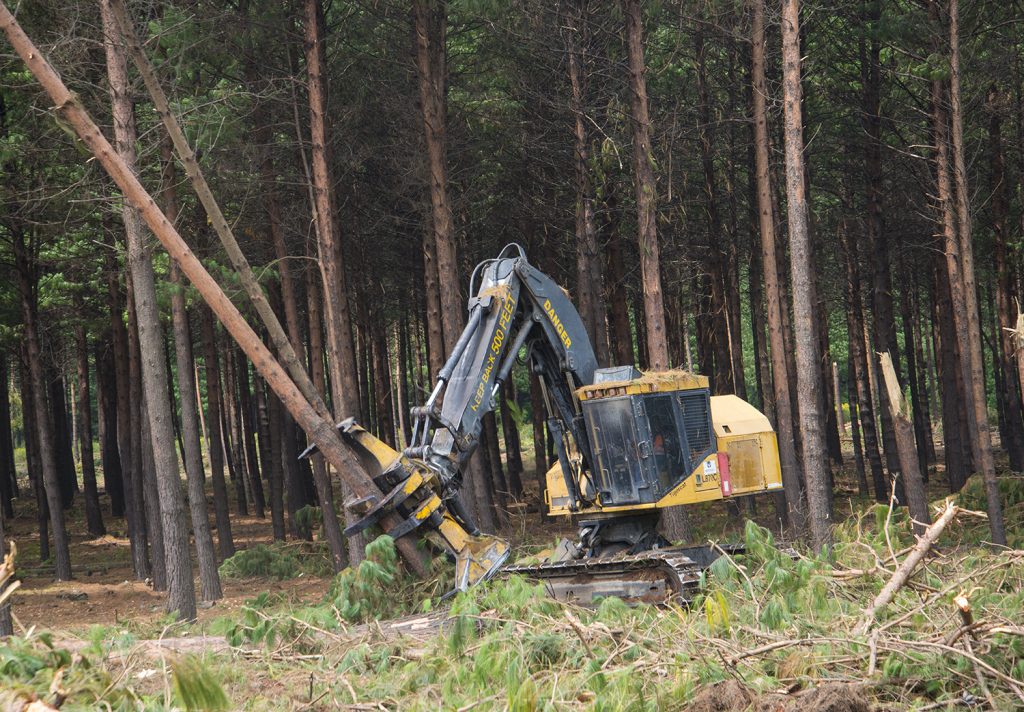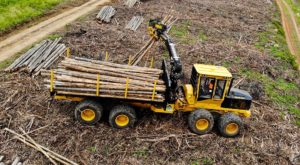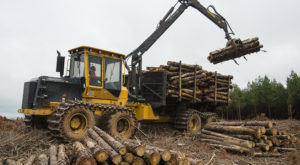– Gary Olsen, international factory sales representative
Tigercat shipped its very first machines – 720D wheeled feller buncher and a 630C grapple skidder – to South African dealer, AfrEquip in July 2005. In the ensuing eighteen months, the Tigercat machine population in the South African forest industry exploded reaching over 50 units by middle of 2007.
In July 2005 the South African Rand to USD exchange rate sat at exactly ZAR 6.68 and by the end of 2006, the rate had moved marginally to ZAR 7. Hay was certainly made while the sun shone and suffice to say had more hay been made the industry could have found its ability to control harvesting costs much easier than it does in today’s environment.
In USD terms, these exact same machines save for safety, technology, efficiency and ergonomic improvements have risen by an average of 1.5% per annum over the past 12 years or 21% but because of the Rand devaluing against the USD, (13 in February, 2017) the real increase is actually 5% annum or 60% in total. One can immediately appreciate that planning a traditional machine replacement strategy under such a dramatically changed financial scenario has become prohibitive. So what has the Plan B been over the past 10 years?
Some customers, having seen the longevity value in a Tigercat purpose-built machine, have imported relatively low hour used machines from other parts of the world, feeling they almost have invested in a new Tigercat for half the price. This is a common practice we see happening with loggers in other African countries as well.
Recently, Tigercat embarked on a countrywide visit involving a range of customers from large forestry companies all the way to small, single machine contractors. The goal was to determine how they have coped all this time, how they feel about having purchased their purpose-built Tigercats and whether the initial investment was worth it in the long run.

A 20,000 hour forwarder is a relative ‘baby’ in South Africa
All of these customers agreed that having forked out this amount of capital to get going, they absolutely needed to run their high quality purpose-built Tigercat machines for a long time to bring capital costs down — longevity is everything. When running and relying on high hour machines, most customers stressed the need to have good workshop facilities, mechanical expertise and service self-sufficiency to make the numbers work.
Even with the current exchange rate there have been some recent purchases of new Tigercat cable and grapple skidders, but the reality is that there are a vast number of machines that continue to operate that are fast approaching the 40,000 machine hour mark. These machines are integral to the operations that they belong to, as opposed to being merely spare machines. Engines and in some cases hydraulic pumps, motors, transmissions and final drives might have been replaced, but for the most part, everything else on the machines seemed to still be on their “first life”. Some customers, having seen the longevity value in a Tigercat purpose-built machine, have imported relatively low hour used machines from other parts of the world, feeling they almost have invested in a new Tigercat for half the price. This is a common practice we see happening with loggers in other African countries as well.

Track undercarriages are reportedly lasting up to 30,000 hours.
The feedback on the life of tracked undercarriage running components was varied and it seemed to boil down to the practice of when you track a machine to the next compartment and when you call for the flatbed truck. Tracked undercarriage running components that were not allowed to track excessively lasted into very high hours up to 30,000 hours while numbers as low as 3,000 hours were the norm for machines that were constantly tracked to the next compartment sometimes as far as 20 km (12 miles)!
AfrEquip maintained flexibility with the location of its spare parts, not insisting on keeping spares at the company’s nearest branch, but rather at the customer’s premises.
Every single customer visited realized in the early stages of running mechanized harvesting operations that a certain amount of inventory of spare parts had to be carried on site and to this end AfrEquip maintained flexibility with the location of its spare parts, not insisting on keeping spares at the company’s nearest branch, but rather at the customer’s premises.

Regular stock control and replenishment of the parts consumed proved a bit of a learning curve initially, but in the end, the will to make the system work prevailed. In addition, many customers in the initial stages of the learning curve would loath to replace entire assemblies like cylinders, pumps, motors or transmissions and rather attempt to open up the assembly and try repairing just the internal components that had failed. This process proved to be more costly especially when considering the downtime. These days, customers are accustomed to a quick swap out of the faulty component with a new one, and then have the failed component repaired and returned to their spare parts inventory as an eventual back up.
Having a high degree of mechanical availability is another critical measure that has been monitored and managed over time. Most customers having come from a history of using converted agriculture or construction equipment to run a logging job were rapidly convinced when they saw their purpose-built machines achieving as much as 25% more mechanical availability than what they were accustomed to. They have been further amazed at how most of their purpose-built machines have been able to maintain 90% mechanical availability even with hours as high as 30,000. In general, it is accepted that harvesting heads (especially when debarking Eucalyptus) have a tough job and so often purpose built carriers are at the mercy of the harvesting head for their mechanical availability performance numbers. Separate the two entities and the carrier number looks even better.
The experience over the years with machine operators has been mixed given that there was not a large pool of proficient operators of mechanized equipment when the fi rst wave of Tigercat machines entered the country from 2005 to 2007. The larger forest companies were generally hardest hit when it came to operator turn over and the proverbial “musical chairs” was the order of the day as trained, profi cient operators moved around the landscape in seek of a few more Rand. Over time, the pool of operators became suffi ciently large enough and things have certainly settled down. Most operators are paid a basic wage and then an incentive scheme linked to productivity, work quality and machine uptime. All of the operations involved two or three shifts per day so machines are continuing to acquire 16-18 machine hours per day.

Overall, from our visit, we determined that Tigercat customers have been extremely happy with their decision and loyalty towards purpose-built machinery over conversions or adapted equipment meant for either the construction or agricultural industries. Great machine performance in high duty cycles, tough terrain conditions and high ambient temperature together with superior safety standards, as well as high mechanical availability and ultimately superior productivity are what sets purpose built machinery apart from the rest.
South African currency devaluation has been a major challenge for all harvesting companies as they have not had the opportunity to implement a desirable and proper machine fleet replacement strategy. However, there is a collective belief that something has to give in the future and purchasing more Tigercats is inevitable to address the need for mechanized harvesting in South Africa.







